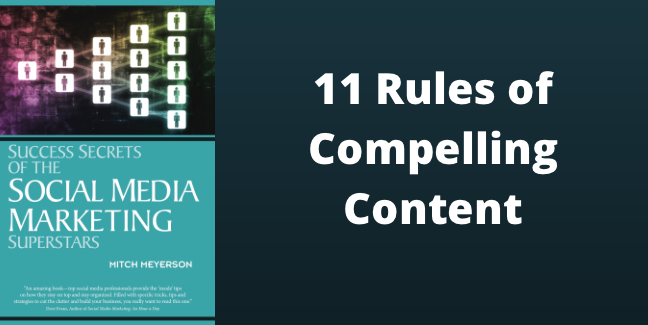Ann Handley is the Chief Content Officer at MarketingProf.com. Who better to ask about writing compelling content?
In this extract from Ann’s comprehensive chapter in the Success Secrets of the Social Media Marketing Superstars, she shares her eleven rules for publishing compelling content inspired by E. B. White’s principles of clarity, brevity and boldness.
“Produce great stuff, and your customers will come to you. Produce great stuff, and your customers will share your story for you. More than ever before: Content is king! Content rules!” Ann Handley
Rule #1: Compelling content has an objective
In the context of business, the juiciest kind of content is created for a purpose, with a business objective in mind.
Who does this well: Hubspot. Based in Cambridge, Mass., Hubspot is a B2B company that sells lead generation systems for small and medium-sized companies. Hubspot is the poster child for content marketing done well, because the best of what it publishes isn’t about Hubspot, it’s about the needs of its audience. And it publishes a ton of it, too: Hubspot’s marketing team publishes all kinds of free content and tools with an eye toward helping their target businesses work harder and smarter.
Like what? Like a blog. Like a weekly news-based web TV show. Like the occasional music video. Like whitepapers, ebooks, webinars, ranking tools, and more. I particularly like that Hubspot hired a former journalist to head its content creation.
Rule #2: Compelling content is vendor-agnostic
Today’s businesses must think like a publisher of information that meets the needs of its audience. Don’t just plug your own products and services; first help your audience and educate them.
Who does this well: MarketingProfs. My own efforts at the company I work for, MarketingProfs, is an example of what I mean: Much of our content is written or produced by outside writers or speakers who are leveraging MarketingProfs as a platform that allows them to become known as trusted experts. Often, my job as editor is to school our writers in the art of producing content that positions them as trusted expert, not merely as salesman of a product or service. In other words, don’t talk about you; talk about your customers and their problems, then offer up a vendor-agnostic solution.
Rule #3: Compelling content is trustworthy
If your customers are to buy from you, they must first trust you as a good resource of information. Your content must be relevant to their needs, and it must be delivered consistently, preferably on a regular schedule you set.
Who does this well: The Rubbermaid blog is a good example—because it focuses not on injected molded plastics but on space-saving and organizing, as well as on the consumers interested in, and the industry built up around, those issues. Consider these recent posts: “How to Sell Clothing at a Yard Sale,” and “Save Money By Packing Your Lunch!”
Rule #4: Compelling content is engaging
What “engaging” is depends on the needs of your audience as well as your objectives. But create a fresh voice or tone or point of view to set your content apart.
Who does this well: Deliver Magazine, which the US Postal Service publishes in print form as well. The audience is direct marketers, clearly an audience that the Postal Service wants to have a friendly conversation with. But what I love about Deliver Magazine is the fresh and fun voice it’s written in. Its staffers call themselves iconoclastic and plucky—and they get a shout from me here for adding a bit of fun to an otherwise boring subject like direct mail.
Rule #5: Compelling content allows for interaction or dialogue
Blogs, Twitter, community sites or social platforms all allow your customers (or potential customers) to interact with you, your brand, or the people who work for you.
Who does this well: Nike’s community site, Nike Plus, does a nice job of building brand loyalty via online social networking, because it focuses on what runners like: it tracks data for a participant’s every run, allows users to share data and goals with other runners, and links runners around the world based on their shared love of running. In August 2009, for instance, 800,000 runners logged on and signed up to run a Nike-sponsored 10K race simultaneously in twenty-five cities. In its first two years of the community site, Nike’s market share of running shoes sales in the US went from 48% to 61%; some observers credit the site for that jump.
Rule #6: Compelling content speaks the language of your customers
Or at least, it speaks plainly. Consider this, from a B2B company’s blog header: “Extraprise combines the strategy, business processes, implementation, and technical support skills of a CRM Systems integrator with the data management, analytic, and marketing skills of a database marketing service provider to deliver and operate closed-loop marketing and sales environments for our clients.”
I don’t mean to pick on Extraprise’s blog here, but make sure your content sounds like it was written by a human.
Who does this well: Thrillist’s editorial voice is so distinct and finely honed that I’d recognize it anywhere. The email newsletter/web site has an edgy, funny, sharp and very human perspective that matches its hip, young, and usually male audience.
Here’s what it says on its site about its daily email publication: “Each weekday, we’ll drop you a must-have recommendation, from the best of what’s new, to deeply under-the-radar goodness. We’re talking absinthe-only cocktail spots, eateries that dish up BBQ Rattlesnake Salad and Reindeer in Bourbon Sauce, and ATMs whose currency is marijuana—handy, although after making a withdrawal, you’ll feel even more paranoid about the stocking repercussions of consuming Santa’s only friend.”
See what I mean?
Rule #7: Compelling content meets your audience where they are—specifically
Maybe your audience is online, but where? For example, if you target grandparents, you might find they use email but aren’t on social networks. If you target the buyers of the latest gadgets, they are probably online. Do some research—survey your audience, set up what Chris Brogan calls “listening posts” on various social networks, and you’ll begin to get a clear sense of where your target audience is.
Who does this well: Sony knows that its audience is fairly sophisticated and will seek out information online, so it created the Sony101 learning center site . The site does a great job of meeting the needs of those who are looking to either buy cameras or get more out of their camera’s functionality.
Rule #8: Compelling content is well-executed
General Mills offers another approach to a social site for its customers who are looking for coupons, or recipes, or who want to get a sneak peek of General Mills products. Or so it appears…. Actually, I tried to check out the General Mills Pssst site but I got so frustrated by the pages and pages of qualifying questions that I gave up. And then, later, I noticed this comment on Twitter by Social Media strategist Paul Gillin, and I felt validated:
“General Mills’ Psst… branded community is almost embarrassingly bad.”
As a big consumer products company, General Mills had an opportunity to take a leadership role in developing an online community with interesting “members-only” content that offered an insider view of some beloved products. Instead, all they produced was a poor excuse of a community site: The “My Profile” doesn’t allow for real interaction with other members, and as Paul Gillin points out on his blog, “That is not a profile; it is a contact form.”
Who does this well: Lots of companies, actually. But I’ve included one that didn’t as a cautionary tale: Creating content is good, but not if you do it badly.
Rule #9: Compelling content experiments a little
Maybe you don’t know exactly where your audience is, or you don’t know whether a blog will attract readers. It’s good to experiment a little. The social media space is still a bit like the Wild West.
Here’s the reality: 44% of marketers have been using social media for only a few months and 28% are just getting started. One way to think about this statistic is that it shows how much experience your competitors probably have in social media: it’s unlikely you are at a disadvantage, even if you are fairly new to the tactic yourself.
As MENG chairman Richard Guha says, “While many marketers are worried they’re missing the boat, in reality even the Fortune 500 companies don’t feel they’ve mastered social media just yet.”
In the words of Stanford academic BJ Fogg, “You probably won’t get it right the first time. That’s okay.”
Rule #10: Compelling content creates Hot Triggers
BJ Fogg also points out that platforms succeed in part because they place “Hot Triggers” in the path of a user of consumer. A Hot Trigger, as BJ defines it, is an action a user can take right now, as opposed to a Cold Trigger, which is basically a call to action that the user can’t perform right now. A billboard asking you to check out the Wall Street Journal, for example, is a Cold Trigger, whereas a newspaper vendor handing you a copy of the Journal on your way into the subway is a Hot Trigger.
From a content perspective, think about what action you want your reader or user or viewer to take. What do you want them to do next? And then create a path for them.
Who does this well: Proctor & Gamble’s Being Girl site is a kind of online “club” for tween and teen girls. Being Girl puts dozens of Hot Triggers in the path of visitors by including words like “updated” next to content categories with new information, encouraging them to play games, sign up for a “private locker” space, and other things designed to appeal to middle school and high school girls. And, by the way, the content on this site is top shelf, and the P&G product branding, while visible, takes a back seat to the information girls go there to find.
Rule #11: Compelling content is search-optimized
This rule could be a whole book unto itself. And, in fact, there are plenty of good books and resources on the market than can coach you through the task of optimizing your content for search.
But here are my two pesos: My fundamental perspective is that the content comes first, and the needs and preferences of the search engines second. After all, the content you are producing must meet the needs of a user; he or she should love what they find when they find you. But that said, don’t ignore search basics, either, because you do want to be found. Some of those basics: Use descriptive language in any content you produce (“our fuzzy pink socks” is better than “our garments,” focus on search phrases your customers might look for (“birthday greeting cards” vs. “cards,” mention your location, and add variations on keywords phrases (like plural, tenses, etc.)
Who does this well: Rather than list specific businesses here, I’ll offer resources. Lee Odden and Jill Whalen are excellent online sources of information for businesses that want to dig deeper on this topic.
BONUS RULE: Compelling content starts a conversation
Make it as easy as possible for your customers to share your content. Don’t force them to sign up to access your content by putting it behind a registration page. Encourage sharing by including sharing widgets, or Send to a Friend buttons, and the like.
The key, after all, is to converse with your customers—if you ever hope to attract them in the first place, not to mention keep them. And there’s nothing better than using your content as a starting point in being social—as a kind of cornerstone for building an environment where customers can have a conversation with your company as well as with each other.
Ann Handley is the Chief Content Officer of MarketingProfs.com which provides strategic and tactical marketing know-how for business professionals. She is also a writer who blogs at the MarketingProfs Daily Fix, the Huffington Post and Mashable. Visit her blog, Annarchy.


